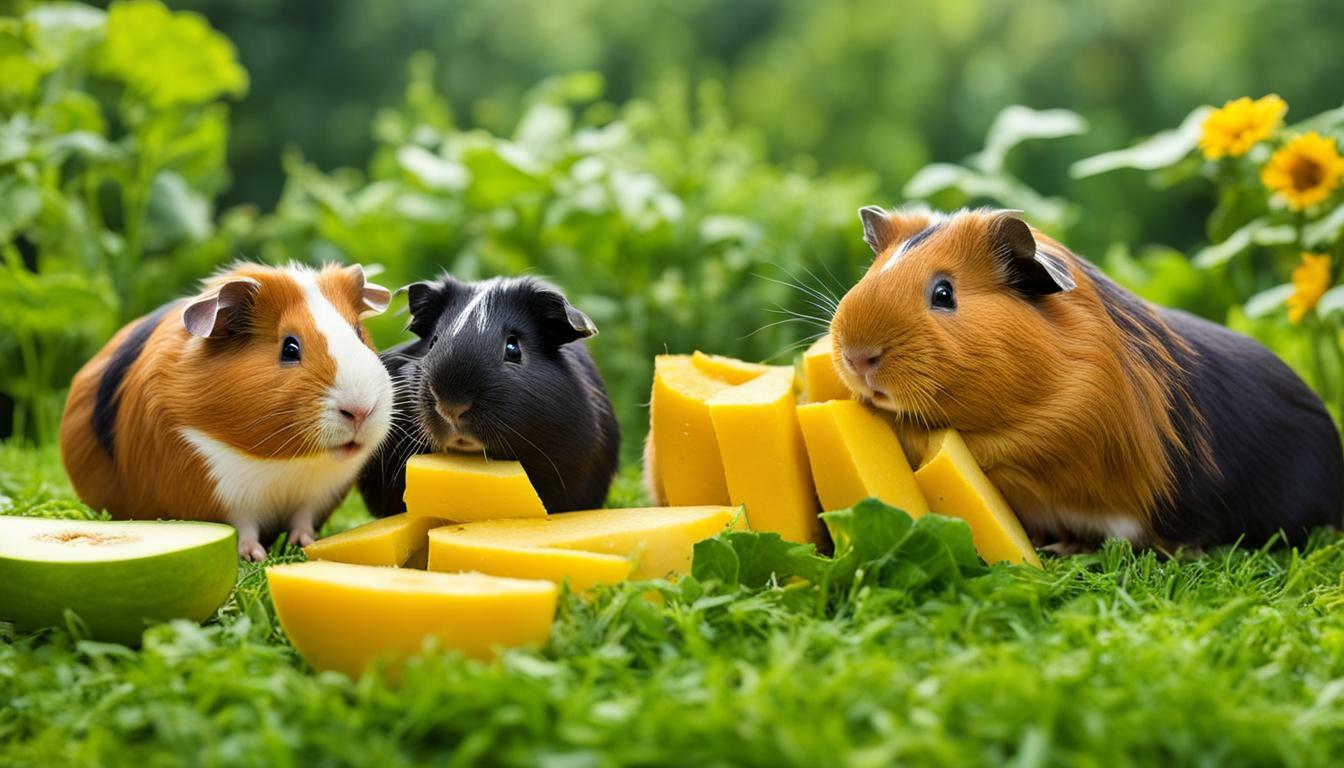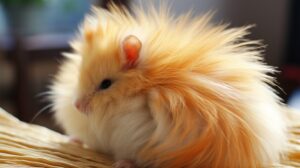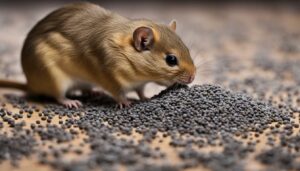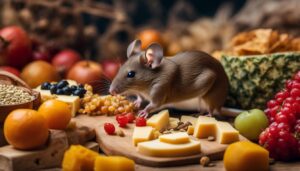If you’re wondering whether it’s safe to feed your guinea pig yellow squash, you’ve come to the right place. Yellow squash, along with other summer squashes like zucchini, is generally safe for guinea pigs to eat. Not only does it provide essential vitamins and minerals, but it also adds variety to their diet. However, it’s important to understand the proper serving size and frequency to ensure their health and well-being.
Key Takeaways:
- Yellow squash is safe for guinea pigs and can be a nutritious addition to their diet.
- It contains essential vitamins and minerals, including vitamin C, which is important for guinea pig health.
- Squash should be fed in moderation, about twice per week, to avoid potential health issues.
- Thoroughly wash the squash and cut it into small pieces, leaving the skin intact for maximum nutrient content.
- Serve the squash raw to preserve its nutritional value.
Understanding Guinea Pig Diets
Guinea pigs have specific dietary requirements that must be met to ensure their overall health and well-being. As herbivores, their diet should consist primarily of fresh hay, a variety of vegetables, and a small amount of fortified guinea pig pellets. Introducing yellow squash into their diet can provide them with additional nutrients and variety.
Yellow squash, along with other summer squashes like zucchini, is safe for guinea pigs to eat. It contains essential vitamins and minerals, including vitamin C, which is crucial for their health. However, it’s important to feed squash in moderation to prevent potential health issues that can arise from excessive consumption.
When incorporating yellow squash into your guinea pig’s diet, remember to wash it thoroughly to remove any dirt or pesticides. Cutting it into small, bite-sized pieces is recommended, as it makes it easier for your furry friend to eat. It’s crucial to leave the skin intact, as it contains nutrients that are beneficial for your guinea pig.
| Feeding Guidelines for Yellow Squash | |
|---|---|
| Frequency | About twice per week |
| Serving Size | 1-2 slices |
| Preparation | Thoroughly wash and cut into small pieces |
It’s worth noting that squash should be served raw and not cooked. Cooking can alter the nutritional composition and potentially cause digestive issues for your guinea pig. By following these guidelines, you can introduce yellow squash as a nutritious addition to your guinea pig’s diet, providing them with essential vitamins and minerals while maintaining their overall health.
The Nutritional Value of Yellow Squash
Yellow squash is packed with important vitamins and minerals that can contribute to your guinea pig’s overall nutrition. This summer squash variety is low in calories and high in water content, making it a hydrating and refreshing snack for your furry friend. Yellow squash is rich in vitamin C, which is crucial for the health and well-being of guinea pigs. Vitamin C plays a vital role in immune function, collagen production, and the absorption of iron. It also acts as an antioxidant, protecting the body against free radicals and promoting overall health.
In addition to vitamin C, yellow squash is a good source of other essential nutrients. It contains vitamins A, B6, and K, as well as minerals like potassium, magnesium, and manganese. These nutrients support various functions in your guinea pig’s body, such as proper growth and development, maintenance of healthy skin and coat, and the formation of strong bones and teeth.
When feeding yellow squash to your guinea pig, it’s important to do so in moderation. While it offers many nutritional benefits, excessive consumption can lead to health issues. Guinea pigs should have a balanced diet that includes a variety of vegetables, hay, and pellets. Aim to serve yellow squash to your guinea pig about twice per week and provide a variety of other vegetables to ensure a well-rounded diet.
| Nutrients | Amount per 100g |
|---|---|
| Vitamin C | 17.1mg |
| Vitamin A | 37µg |
| Vitamin K | 4.3µg |
| Potassium | 262mg |
| Magnesium | 18mg |
| Manganese | 0.14mg |
When serving yellow squash to your guinea pig, make sure to wash it thoroughly to remove any dirt or residue. You can leave the skin intact, as it contains valuable nutrients. Cut the squash into small, bite-sized pieces that are easy for your guinea pig to eat. It’s important to serve the squash raw and not cook it, as cooking can cause a loss of nutrients. By following these guidelines and incorporating yellow squash into your guinea pig’s diet in moderation, you can provide them with a nutritious and tasty treat.
Vitamin C and Guinea Pigs
Guinea pigs, like humans, require vitamin C to maintain their health, and yellow squash is a great source of this essential nutrient. It is important to ensure that your guinea pig receives enough vitamin C in their diet, as they cannot produce it naturally on their own. Yellow squash contains a good amount of vitamin C, helping to support your guinea pig’s immune system, promote healthy skin and coat, and aid in the absorption of other nutrients.
When feeding yellow squash to your guinea pig, it’s crucial to do so in moderation. While vitamin C is important, overfeeding can lead to urinary problems and digestive issues. It is recommended to offer yellow squash to your guinea pig about twice per week, alongside other fresh vegetables and a balanced diet of hay and pellets. Variety is key in a guinea pig’s diet, so be sure to include other safe foods to provide a well-rounded nutritional intake.
When preparing yellow squash for your guinea pig, make sure to wash it thoroughly to remove any dirt or pesticides. Leave the skin intact, as it contains valuable nutrients. Cut the squash into small, bite-sized pieces that are easy for your guinea pig to chew and digest. It is best to serve yellow squash raw, as cooking can destroy some of its nutritional value. Always remove any uneaten portions of squash from your guinea pig’s enclosure to prevent spoilage and potential health risks.
| Nutrient | Amount per 100g |
|---|---|
| Vitamin C | 17.1mg |
| Calcium | 25mg |
| Phosphorus | 36mg |
| Potassium | 204mg |
In conclusion, yellow squash can be a nutritious addition to your guinea pig’s diet. It provides a good source of vitamin C, which is essential for their well-being. Remember to feed yellow squash in moderation, alongside a varied diet that includes other safe foods for guinea pigs. With proper preparation and serving, yellow squash can contribute to the overall health and happiness of your furry friend.
Moderation is Key
While yellow squash can be a healthy addition to your guinea pig’s diet, it’s crucial to provide it in moderation to prevent any adverse effects. Guinea pigs have specific dietary needs, and overfeeding them with any food, including yellow squash, can lead to health issues.
As a summer squash, yellow squash is packed with vitamins and minerals that are beneficial for your guinea pig’s overall health. It contains vitamin C, which is essential for their immune system and helps prevent scurvy. However, feeding too much yellow squash to your guinea pig can result in urinary problems and digestive discomfort.
To introduce yellow squash into your guinea pig’s diet, start with small portions and observe their reaction. Recommended serving sizes for yellow squash should be about a tablespoon per serving, and it’s best to provide it to them twice a week. This ensures that they get the nutritional benefits without overloading their system.
| Vitamin Content in Yellow Squash per 100g | Amount |
|---|---|
| Vitamin C | 27.0 mg |
| Vitamin K | 0.5 μg |
| Vitamin A | 20.9 IU |
When feeding yellow squash to your guinea pig, make sure to wash it thoroughly to remove any dirt or pesticides. Leave the skin intact, as it holds the most nutrients. Cut the squash into small, manageable pieces to prevent choking hazards. Serve it raw rather than cooked, as cooking can lead to a loss of essential nutrients.
Remember, while yellow squash can provide nutritional benefits to your guinea pig, it should always be given in moderation as part of a varied diet. Ensure your pet has access to fresh hay, water, and other guinea pig-friendly vegetables to maintain a balanced and healthy diet.
Preparing Yellow Squash for Your Guinea Pig
Before serving yellow squash to your guinea pig, it’s important to ensure it is prepared correctly to maximize its nutritional benefits. Guinea pigs enjoy the crisp texture and mild flavor of raw yellow squash, making it a great addition to their diet. Here are some guidelines to follow when preparing yellow squash for your furry friend.
First, make sure to choose fresh, firm yellow squash. Wash the squash thoroughly under running water to remove any dirt or residue. It’s best to leave the skin intact, as it offers additional nutrients. However, if your guinea pig has trouble digesting the skin, you can carefully peel it off.
Next, slice the yellow squash into small, bite-sized pieces. Guinea pigs have small mouths and delicate teeth, so providing appropriately-sized portions ensures they can easily eat and digest their food. The recommended size for yellow squash pieces is approximately ½ inch cubes.
| Preparation Steps: | Summary: |
|---|---|
| Choose fresh, firm yellow squash. | Ensures the squash is in optimal condition for consumption. |
| Wash the squash thoroughly under running water. | Removes any dirt or residue from the squash. |
| Leave the skin intact or peel it off, if necessary. | Skin offers additional nutrients but can be removed if it causes digestive issues. |
| Slice the yellow squash into small, bite-sized pieces. | Ensures the squash is easy for guinea pigs to eat and digest. |
Now that your yellow squash is prepared, it’s time to serve it to your guinea pig. Place the slices in their food dish and observe their enjoyment as they nibble on this delicious and nutritious treat. Remember to feed yellow squash in moderation, about twice per week, to avoid any potential health issues.
Serving Size and Frequency
To maintain a balanced diet for your guinea pig, it’s crucial to understand the correct serving size and frequency of yellow squash. While yellow squash is safe for guinea pigs to eat and provides essential nutrients, it should be offered in moderation to prevent any potential health issues.
As a general guideline, feeding your guinea pig a small portion of yellow squash two times per week is recommended. This ensures that they receive the benefits of its nutritional content without overloading their system. It’s important not to exceed this amount, as excessive consumption of squash can lead to digestive problems and urinary issues in guinea pigs.
To prepare the yellow squash for your furry friend, start by washing it thoroughly to remove any dirt or pesticides. Leave the skin intact, as it contains valuable nutrients. Next, cut the squash into small, bite-sized pieces that are easy for your guinea pig to chew and digest. Remember to remove any seeds before serving.
| Serving Size | Frequency |
|---|---|
| Small portion | Twice per week |
Feeding yellow squash to your guinea pig can add variety to their diet and provide them with essential vitamins, especially vitamin C. However, it’s important to remember that yellow squash should not be the sole focus of their meals. Guinea pigs require a balanced diet consisting of various vegetables, hay, pellets, and fresh water.
If you notice any signs of digestive issues, such as loose stools or decreased appetite, it’s advisable to reduce or discontinue the amount of yellow squash temporarily. Additionally, if your guinea pig shows signs of allergies, such as itchiness or sneezing, it’s best to consult with a veterinarian to determine the cause.
By incorporating yellow squash into your guinea pig’s diet in the appropriate serving size and frequency, you can ensure they receive the nutritional benefits without compromising their health. Remember, a varied and balanced diet is key to keeping your furry friend happy and healthy!
Potential Risks and Considerations
While yellow squash is generally safe for guinea pigs, there are some factors to consider to ensure your pet’s well-being. It’s important to feed squash in moderation, as excessive consumption can lead to urinary problems and stomach discomfort. As a summer squash, yellow squash should be given to guinea pigs no more than twice per week.
When preparing yellow squash for your guinea pig, make sure to wash it thoroughly to remove any pesticides or dirt that may be present on the skin. It’s also recommended to keep the skin intact while cutting the squash into small pieces, as this maximizes the nutrient content. Feeding squash raw is preferable, as cooking can diminish its nutritional value.
In addition to moderation, it’s crucial to provide a balanced diet for your guinea pig. While yellow squash can be a nutritious addition, it should not be the sole food source. Guinea pigs require a variety of vegetables, hay, and pellets to meet their nutritional needs. Consult with a veterinarian or a guinea pig expert to ensure that your pet’s diet is well-rounded.
| Potential Risks and Considerations | Guidelines |
|---|---|
| Feeding Frequency | No more than twice per week |
| Preparation | Thoroughly wash and keep the skin intact while cutting |
| Food Variety | Include a variety of vegetables, hay, and pellets in the diet |
By following these guidelines and considering the individual needs of your guinea pig, you can safely incorporate yellow squash into their diet. Remember to monitor your pet’s response to the new food and consult a professional if you notice any signs of allergies or digestive issues. With proper care and attention, your guinea pig can enjoy the nutritional benefits of yellow squash while maintaining a balanced and healthy diet.
Variety in a Guinea Pig’s Diet
Offering a diverse range of foods, including yellow squash, can help meet the nutritional needs of your guinea pig and keep them happy and healthy. Guinea pigs are herbivores and need a balanced diet that includes fresh vegetables, hay, and pellets. Yellow squash, along with other vegetables, provides essential vitamins and minerals that contribute to their overall well-being.
When introducing yellow squash into your guinea pig’s diet, it’s important to do so gradually. Start by offering small pieces and observe how your guinea pig reacts. Some guinea pigs may prefer other vegetables, so it’s important to monitor their preferences.
Here is a table to guide you on the appropriate serving size of yellow squash for your guinea pig:
| Guinea Pig Weight | Serving Size of Yellow Squash |
|---|---|
| Up to 1 pound | 1-2 small slices |
| 1-2 pounds | 2-4 small slices |
| 2-3 pounds | 3-6 small slices |
| Above 3 pounds | 4-8 small slices |
Remember to balance yellow squash with other vegetables to ensure a varied diet. Along with yellow squash, popular vegetable options for guinea pigs include bell peppers, carrots, and leafy greens like romaine lettuce and spinach. Mixing different vegetables can provide your guinea pig with a range of nutrients that they need to thrive.
Other Safe Foods for Guinea Pigs
In addition to yellow squash, there are several other safe and nutritious foods that you can incorporate into your guinea pig’s diet. These foods provide variety and help ensure that your pet receives a well-rounded nutritional intake.
One option is leafy green vegetables such as spinach, romaine lettuce, and kale. These greens are rich in essential vitamins and minerals and can be given daily in small amounts. Remember to wash them thoroughly before serving to remove any pesticides or dirt.
Another safe food for guinea pigs is bell peppers. These colorful vegetables are an excellent source of vitamin C and can be given in small slices. Red, yellow, and green bell peppers are all suitable options.
Fruits like apples, pears, and strawberries can also be included in your guinea pig’s diet. However, it’s important to remove any seeds or pits, as they can be harmful. Serve these fruits in small, bite-sized pieces to prevent choking.
| Foods | Serving Size | Frequency |
|---|---|---|
| Leafy Green Vegetables (Spinach, Romaine Lettuce, Kale) | Small Amounts | Daily |
| Bell Peppers (Red, Yellow, Green) | Small Slices | Twice per Week |
| Apples, Pears, Strawberries | Small Pieces | Twice per Week |
Remember, when introducing new foods into your guinea pig’s diet, do so gradually to allow their digestive system to adjust. Monitor your pet’s reaction to each food, and if any signs of allergies or digestive issues arise, discontinue feeding and consult a veterinarian.
Summary:
- Include a variety of safe and nutritious foods in your guinea pig’s diet.
- Leafy green vegetables like spinach, romaine lettuce, and kale are a good daily option.
- Bell peppers, including red, yellow, and green varieties, provide vitamin C.
- Fruits such as apples, pears, and strawberries can be given in small amounts.
- Introduce new foods gradually and monitor your guinea pig for any adverse reactions.
Signs of Allergies or Digestive Issues
While yellow squash is generally safe for guinea pigs, it’s important to be aware of any adverse reactions or digestive issues that may arise. Some guinea pigs may have allergies or sensitivities to certain foods, including yellow squash. If your guinea pig shows any signs of allergies or digestive problems after consuming yellow squash, it’s recommended to discontinue feeding it to them and consult with a veterinarian.
Signs of allergies in guinea pigs may include itching, redness, or swelling around the mouth, nose, or ears. They may also experience respiratory symptoms like sneezing, wheezing, or difficulty breathing. Digestive issues can manifest as diarrhea, constipation, bloating, or a lack of appetite. If you observe any of these symptoms, it’s important to seek professional advice to determine the best course of action for your guinea pig’s health.
To monitor your guinea pig’s reactions to yellow squash, it’s recommended to introduce it gradually into their diet. Start with a small amount and observe their response over the next 24 to 48 hours. If there are no adverse reactions, you can gradually increase the portion size. Remember to always provide fresh water alongside their meals and ensure a balanced diet that includes a variety of vegetables, hay, and guinea pig pellets.
Table 1: Common Signs of Allergies or Digestive Issues in Guinea Pigs
| Signs of Allergies | Signs of Digestive Issues |
|---|---|
|
|
Remember, every guinea pig is unique, and their tolerance to certain foods can vary. What may be safe for one guinea pig may not be well-tolerated by another. It’s essential to monitor your pet closely and make dietary adjustments based on their individual needs. Consulting with a qualified veterinarian is always recommended when introducing new food items or if you have concerns about your guinea pig’s health.
Conclusion
Yellow squash can be a nutritious addition to your guinea pig’s diet when offered in moderation and proper preparation. As a type of summer squash, yellow squash is safe for guinea pigs to consume and provides essential vitamins and minerals, including vitamin C. This vitamin is particularly important for guinea pigs, as they cannot produce it on their own and require it from their diet.
However, it’s crucial to feed yellow squash to your guinea pig in moderation, typically about twice per week. Excessive consumption of squash can lead to urinary problems and stomach discomfort for your pet. By offering yellow squash in appropriate amounts, you can ensure that your guinea pig benefits from its nutritional value without any negative side effects.
When including yellow squash in your guinea pig’s diet, it’s important to follow proper preparation techniques. Thoroughly wash the squash to remove any dirt or residue. Keep the skin intact, as it contains valuable nutrients. Cut the squash into small, bite-sized pieces to make it easier for your guinea pig to eat and digest.
Remember, yellow squash should be served raw and not cooked. Cooking can eliminate some of the essential nutrients that your guinea pig needs. By offering raw yellow squash, you provide your pet with the maximum benefit from its vitamins and minerals.
Incorporating yellow squash, along with a variety of other safe foods, can contribute to a balanced and healthy diet for your guinea pig. Just be sure to watch for any signs of allergies or digestive issues when introducing new foods. If you notice any adverse reactions, consult your veterinarian for further guidance.
In conclusion, yellow squash is a nutritious option for your guinea pig, offering essential vitamins and minerals. By following the guidelines of moderation and proper preparation, you can safely include yellow squash in your guinea pig’s diet for optimal health and well-being.
FAQ
Can guinea pigs have yellow squash?
Yes, guinea pigs can have yellow squash. It is categorized as a summer squash and is safe for guinea pigs to eat.
Why is yellow squash safe for guinea pigs?
Yellow squash, like other summer squashes, contains vitamins and minerals, including vitamin C, which is important for the guinea pig’s health.
How often should I feed yellow squash to my guinea pig?
Yellow squash should be fed in moderation, about twice per week. Excessive consumption can lead to urinary problems and stomach discomfort.
How should I prepare yellow squash for my guinea pig?
It is important to wash yellow squash thoroughly and cut it into small pieces, leaving the skin intact for the maximum nutrient content. Serve it raw and not cooked.
What are the potential risks when feeding yellow squash to guinea pigs?
Feeding yellow squash in excessive amounts can lead to urinary problems and stomach discomfort. It is important to feed it in moderation.
Can I feed my guinea pig other safe foods alongside yellow squash?
Yes, a varied diet is important for guinea pigs. Other safe foods that can be included are hay, fresh vegetables, and limited amounts of fruits.
What are the signs of allergies or digestive issues in guinea pigs?
Signs of potential allergies or digestive issues may include diarrhea, bloating, excessive gas, or changes in appetite. If you notice any of these signs, consult a veterinarian.
Is yellow squash a suitable addition to a guinea pig’s diet?
Yes, yellow squash can be a nutritious addition to a guinea pig’s diet when given in the right amounts. It provides vitamins and minerals that contribute to their overall health.




